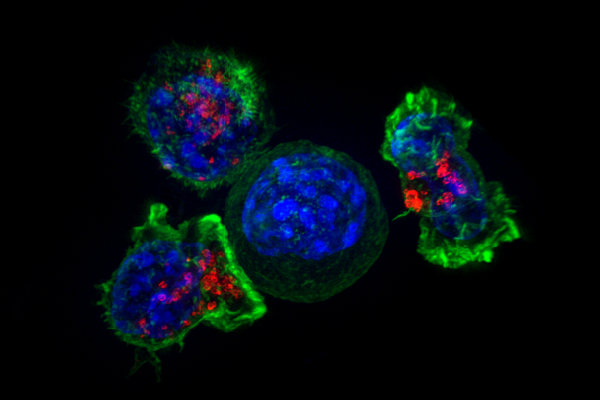
A combination of ibrutinib and venetoclax was found to provide lasting disease remission in patients with newly diagnosed chronic lymphocytic leukemia (CLL), according to researchers at The University of Texas MD Anderson Cancer Center. Findings from the single-institution Phase II study were published today in JAMA Oncology and provide the longest follow-up data on patients treated with this drug regimen.
Lead researchers included Nitin Jain, M.D., associate professor of Leukemia, William Wierda, M.D., Ph.D., professor of Leukemia; and Varsha Gandhi, Ph.D., department chair ad interim of Experimental Therapeutics.
MD Anderson researchers previously reported results from this study showing that ibrutinib and venetoclax were effective when given together for high-risk and older patients with the disease. This report offers an additional two years of follow-up data and statistics on bone marrow undetectable measurable residual disease (U-MRD) after treatment. Overall, the three-year progression-free survival was 93% and the three-year overall survival was 96%. The response rates were the same for the high-risk subgroup of patients.
“CLL is the most common leukemia in the United States and was originally treated with chemoimmunotherapy,” said Jain. “These long-term results show that two years of oral targeted therapy can achieve lasting disease remission for patients with CLL.”
Researchers followed 80 previously untreated patients with a median age of 65 years, 30% of whom were over age 70. Overall, 92% had high-risk genetic anomalies. The median follow-up for all 80 patients was 38.5 months. Trial participants were 94% white, 4% other, 1% American Indian or Alaska Native and 1% unknown.
The U-MRD responses improved with ongoing combined ibrutinib plus venetoclax. After 12 cycles of combination therapy, 56% of patients achieved bone marrow U-MRD, and after 24 cycles of combination therapy, 66% of patients achieved bone marrow U-MRD remission. A total of 75% of patients achieved bone marrow U-MRD remission at any time during the study.
“MRD is one of the most important prognostic markers at the end of leukemia treatment,” said Jain. “The majority of patients achieved bone marrow MRD remission and no patients on the trial had CLL disease progression.”
The research team continues to monitor the patients’ MRD every six months and is working on further correlative studies. The treatment was well-tolerated and the toxicity profile of both drugs was consistent with other studies, with no additional toxicity observed with the combination.
Several ongoing studies are investigating combined BTK inhibitors with venetoclax, including the CAPTIVATE trial, which reported results at the recent American Society of Clinical Oncology (ASCO) annual meeting, the UK FLAIR trial, the CLL17 trial, and the CLL GLOW trial, which will report Phase III results at European Hematology Association (EHA) Virtual Congress. Data from these trials and others will clarify the duration and role of this treatment regimen.
Source: Read Full Article
